

Soon after Shakyamuni Buddha attained enlightenment the four great Great Guardian Kings of the four directions each presented him with an alms-bowl, the most beautiful of which was made of precious gems and the simplest from common clay. Shakyamuni was said to have either chosen the simple clay bowl or to have accepted all four bowls and miraculously convert them into one plain bowl that was sufficient for the needs of a humble mendicant.
The traditional alms bowl of a Buddhist monk or bhikshu is shaped like the inverted head protuberance (Skt. ushnisha) of the Buddha, a symbols of the highest attainment of Buddhahood, as the wisdom the directly realizes emptiness. The alms bowl is generally held in the left “wisdom” hand of seated Buddhas and their disciples, the sangha. This left hand often rest upon the lap in the gesture of meditation, with the alms bowl indicating renunciation and the hand gesture meditation upon emptiness.
Three fruits or gems, representing the trinity of Buddha, dharma and sangha, are also commonly depicted in an alms bowl. The specific attribute of a particular Buddha may also be shown in his alms bowl.
CLICK HERE TO SEE NEW ARRIVALS IN DHARMA SCULPTURE’S GALLERY
